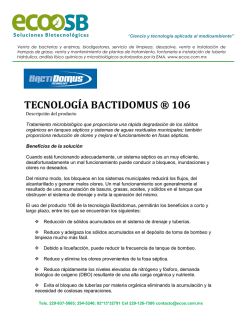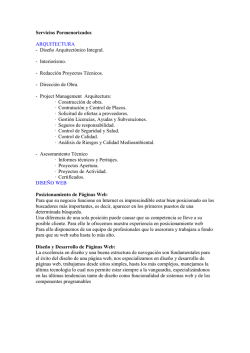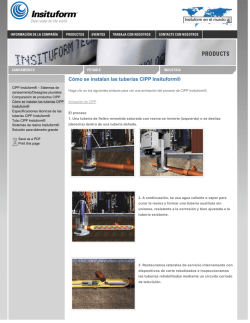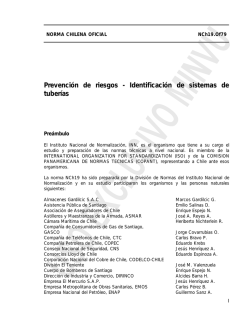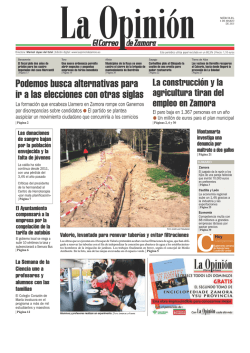
888-883-6308 - Enterprise Products
Take our quick, confidential online survey Register to win an Apple Watch™ See details on back DIXIE PIPELINE VIEWER TOOL AN IMPORTANT MESSAGE ABOUT PIPELINE SAFETY You have received this safety brochure because you have been identified as someone who lives, works or conducts farming activities near a petroleum pipeline operated by Dixie Pipeline Company. To learn more specific information regarding location, size and products transported in our pipelines within one mile of your address, visit our Pipeline Viewer Tool at: www.enterpriseproducts.com/pipelineviewer Department of Transportation statistics confirm pipelines are the safest means of transporting energy. Approximately two-thirds of the natural gas, crude oil and refined petroleum products we use in our everyday lives are transported through underground pipelines – making them an essential component of our nation’s infrastructure. ABOUT US Please take a moment to familiarize yourself with the important pipeline safety information in this brochure. We encourage you to keep it and share with your family, friends and co-workers. OUR SAFETY COMMITMENT Dixie Pipeline Company is committed to the safe, reliable delivery of propane and ethane, also known as Highly Volatile Liquids (HVLs). Our pipelines are designed, installed, tested, operated and maintained according to strict standards employed by our company, the pipeline industry and the federal government. CONTACT DIXIE Website: www.enterpriseproducts.com E-mail: [email protected] Non-Emergency Number: 888-806-8152 IN CASE OF A DIXIE PIPELINE EMERGENCY CALL Emergency Number: 888-883-6308 If you suspect a problem or witness suspicious activity on our right-of-way, immediately notify our 24-Hour Control Center and call your local police and fire department by dialing 911. LEARN MORE Other helpful websites and information can be found on the Additional Resources section of our website at: www.enterpriseproducts.com/pipelinesafety/addlresources/ Damage from excavation-related activities is a leading cause of pipeline accidents. If you are someone who lives, works or conducts farming activities near one of our pipelines, we need your help in preventing pipeline emergencies. The Plan is Simple 1. Call your state’s One-Call Center (by dialing 811) at least two working days before excavation is scheduled to begin. (Some states may require 72 hours before excavation.) 2. Wait the required amount of time. 3. One of our trained technicians will mark the location of the pipeline at no cost to you. 4. Respect the line markers. RED Electric ORANGE Communications, Telephone/CATV BLUE A gouge, scrape, dent or crease to a pipeline or its coating may cause a break or leak in the future. If you cause what could be considered even minor damage to a pipeline, please contact Dixie Pipeline Company immediately at 888-883-6308. Report Damages. It’s the Law. The State of Texas requires reporting of excavation damages to gas and liquid pipeline facilities through the Railroad Commission of Texas (RRC) website. For more details, please visit the RRC website at: www.rrc.state.tx.us/pipelinesafety/enforcement/. 5. Dig with care. GREEN Sewer/Drainage YELLOW Gas/Petroleum PURPLE Reclaimed Water WHITE Pre-mark site of intended excavation PINK Temporary survey markings The table below describes the types of products transported through our pipeline system(s). One or more of these products may be transported in your area. For more specific information regarding location, size and products transported in our pipelines within one mile of your address, visit our Pipeline Viewer Tool at: www.enterpriseproducts.com/pipelineviewer. HAZARDOUS MATERIAL QUICK GUIDE PRODUCT LEAK TYPE Our Damage Prevention Program is designed to prevent damage to our pipelines and facilities from excavation activities such as digging, trenching, blasting, boring, tunneling, backfilling, or by any other digging activity. When/ where applicable, the appropriate stakeholders will be notified of the nature and timing of scheduled maintenance or construction activity on a Dixie pipeline. NATIONAL PIPELINE MAPPING SYSTEM The National Pipeline Mapping System (NPMS) provides information about operators of both gas and liquid transmission pipelines. To find out who operates pipelines in your area, visit the NPMS website at: www.npms.phmsa.dot.gov/. VAPORS Initially heavier than air, spread along ground, collect in low lying areas and may travel to source of ignition and flash back. Product is colorless, tasteless and contains a slight hydrocarbon or pungent odor. Dixie also maintains an ongoing effort to communicate with Emergency Response Agencies to provide information on emergency preparedness and response. Some segments of our pipeline system(s) traverse through areas that have been designated as High Consequence Areas (HCAs) in accordance with federal regulations and require additional activities that are included in our IMP. More information about our company, pipeline operations, HCAs and an IMP summary can be found at: www.enterpriseproducts.com/pipelinesafety/pipelineintegrity/. Colored flags are placed in the ground to temporarily identify the various types of buried utilities, or to indicate planned excavation activity. Please do not remove or relocate these flags as it could lead to possible dangers for yourself and others living and working nearby. PRODUCTS WE TRANSPORT PREVENTION MEASURES We implement a comprehensive pipeline Integrity Management Program (IMP) to maintain the reliability and safety of our pipeline systems. We do this through use of inspection devices, pressure testing, regular and scheduled maintenance, aerial surveillance, corrosion prevention efforts, and 24-hour surveillance of the pipeline. Potable Water COLOR CODING OF TEMPORARY MARKER SIGNS HIGHLY VOLATILE LIQUIDS (HVLS) (PROPANE, BUTANE, ETHANE, E/P MIX) Gas HEALTH HAZARDS Easily ignited by high heat, sparks or flames and will form Additional Information on HVLs: explosive mixtures The products we transport with air. Vapors may through our pipelines include cause dizziness or propane and ethane, also asphyxiation without known as Highly Volatile Liquids warning and may be (HVLs). HVLs are hydrocarbons toxic if inhaled at high that have been pressurized to concentrations. Contact keep them in a liquid state. If with gas or liquefied a pipeline is ruptured, the HVLs gas may cause burns, will escape and convert from severe injury and/ a liquid to a gas and form or frostbite. Fire may gaseous vapor clouds when produce irritating and/ released into the air. HVLs or toxic gases. are highly flammable and will burn or explode if exposed to an ignition source. HVLs are dangerous and could be lethal if inhaled by humans or animals. DAMAGE PREVENTION CALL 811 BEFORE YOU DIG HOW CAN YOU TELL WHERE A PIPELINE IS LOCATED? Look for these signs: Pipeline markers can be found along the right-of-way and where the pipeline intersects a street, highway or railway. Pipeline markers are used to indicate the approximate location of the pipeline - do not rely on them to indicate the exact position of the pipeline as it may not follow a straight course between markers. THE PIPELINE MARKERS DISPLAY: The material transported in the pipeline A telephone number where the operator can be reached in the event of an emergency While markers are helpful in locating pipelines, they provide no information on the depth or number of pipelines in the vicinity. Please ensure that no buildings, structures, trees or other obstructions are erected, placed, or planted on or within the pipeline right-of-way. Pipeline markers are required by the U.S. Department of Transportation and it is a federal crime to remove or relocate them. HOW TO RECOGNIZE A LEAK By Sight •A low-lying, dense white cloud or fog originating near the pipeline •A pool of liquid on the ground •Dead or discolored vegetation amid healthy plants •Water bubbling or being blown into the air •Frozen ground near the pipeline •Fire or explosion near the pipeline WHAT TO DO IN A PIPELINE EMERGENCY By Sound Your first concern should be for your personal safety and the safety of those around you. • An unusual hissing or roaring sound YOU SHOULD DO NOT • • DO NOT drive into an area in which you encounter a leak or vapor cloud. Leave the suspected incident area immediately, walking upwind and uphill (if possible) and stay out of low- lying areas. • Abandon any equipment being used in or near the area. • From a safe location, immediately notify us at 888-883-6308 and notify your local emergency response agencies by dialing 911 to advise them of the emergency. • Prior to the arrival of law enforcement officials, advise others not to enter the area. • DO NOT light a match, start or stop an engine or automobile, use a telephone, or switch on/off an electric light or appliance. • DO NOT attempt to extinguish any fire. • DO NOT try to operate any pipeline valves yourself. • DO NOT use a cell phone or other electronic devices near the suspected emergency area. By Smell • Any strange or unusual gaseous odor near the pipeline Dead, discolored vegetation. Water bubbling. Frozen ground. RECOGNIZE & RESPOND The name of the pipeline operator ACERCA DE NOSOTROS PREVENCIÓN DE DAÑOS UN MENSAJE IMPORTANTE SOBRE LA SEGURIDAD EN LAS LÍNEAS DE TUBERÍAS LLAME AL 811 ANTES DE EXCAVAR Usted ha recibido este folleto de seguridad debido a que ha sido identificado como una persona que vive, trabaja o realiza actividades agrícolas cerca de una línea de tuberías de petróleo que es operada por Dixie Pipeline Company. Los daños ocasionados por actividades relacionadas con la excavación son una causa principal de los accidentes en las líneas de tuberías. Si usted vive, trabaja o realiza actividades agrícolas cerca de una de nuestras líneas de tuberías, necesitamos que nos ayude a prevenir emergencias en las líneas de tuberías. EL PLAN ES SIMPLE Las estadísticas del Departamento de Transporte han confirmado que las líneas de tuberías son la manera más segura para el transporte de energía. Aproximadamente dos terceras partes del gas natural, petróleo crudo, y los productos de petróleo refinado que usamos en nuestra vida diaria, son transportados a través de líneas de tuberías subterráneas – convirtiéndolas en un componente esencial de la infraestructura de nuestra nación. 1. Contacte al Centro de Una Llamada de su estado (llamando al 811) por lo menos dos días laborables antes del comienzo de la excavación. (Algunos estados requieren que llame 72 horas antes de excavar.) Por favor tome un momento para familiarizarse con la información importante de seguridad en las líneas de tuberías que se encuentra en este folleto. Le pedimos a que lo conserve y lo comparta con su familia, amigos y compañeros de trabajo. 4. Respete los marcadores de líneas. NUESTRO COMPROMISO CON LA SEGURIDAD Dixie Pipeline Company está comprometida con la entrega segura y confiable de propano y de etano, también conocidos como Líquidos Altamente Volátiles (“HVLs” por sus siglas en inglés). Nuestras líneas de tuberías están diseñadas, instaladas, comprobadas, operadas y mantenidas de acuerdo a estándares muy estrictos usados por nuestra compañía, la industria de líneas de tuberías y el gobierno federal. 2.Espere el tiempo requerido. 3. Uno de nuestros técnicos entrenados marcará la ubicación de la línea de tuberías sin ningún costo para usted. 5. Excave con cuidado. Una muesca, raspadura, abolladura, arruga a una línea de tuberías o a su capa puede provocar una ruptura o fuga en el futuro. Si usted causa lo que incluso se puede considerar como un daño leve a una línea de tuberías, por favor contacte inmediatamente a Dixie Pipeline Company llamando al 888-883-6308. REPORTE DAÑOS. ES LA LEY. El Estado de Texas requiere que los daños ocasionados por excavaciones a las instalaciones de líneas de tuberías de gas y de líquidos sean reportados a través del página del internet de la Comisión de Ferrocarriles de Texas (“RRC” por sus siglas en inglés). Para obtener más detalles, por favor visite el página del internet de RRC en: www.rrc.state.tx.us/pipeline-safety/enforcement/. EN CASO DE UN EMERGENCIA EN LA LÍNEA DE TUBERÍAS DE DIXIE LLAME NÚMERO DE EMERGENCIA: 888-883-6308 Si usted sospecha que existe un problema o presencia una actividad sospechosa en nuestro derecho-de-paso, notifique inmediatamente al Centro de Control de 24-Horas y llame al departamento local de la policía y de los bomberos marcando el 911. HERRAMIENTA DE VISOR DE LÍNEAS DE TUBERÍAS DE DIXIE Para obtener más información respecto a la ubicación, el tamaño, y los productos transportados en nuestras líneas de tuberías que se encuentran dentro de una milla de su dirección, visite a: www.enterpriseproducts.com/pipelineviewer MEDIDAS DE PREVENCIÓN Nosotros implementamos un Programa de Manejo de Integridad (“IMP” por sus siglas en inglés) en las líneas de tuberías que es detallado para poder mantener la fiabilidad y la seguridad de nuestros sistemas de líneas de tuberías. Logramos esto a través del uso de aparatos de inspección, pruebas de presión, mantenimiento regular y rutinario, patrullaje aéreo, medidas de prevención de corrosión, y vigilancia de la línea de tuberías las 24 horas del día. Dixie también mantiene un esfuerzo continuo en la comunicación con las Agencias de Respuesta a Emergencias para proveer información en la preparación y respuesta a emergencias. Algunos segmentos de nuestros sistemas de líneas de tuberías atraviesan áreas que han sido designadas como Áreas de Alta Consecuencia (“HCAs” por sus siglas en inglés) en conformidad con las regulaciones federales y se requiere actividades adicionales que están incluidas en nuestro “IMP”. Usted puede encontrar más información acerca de nuestra compañía, de las operaciones de la línea de tuberías, de las Áreas de Alta Consecuencia (“HCA” por sus siglas en inglés) y un resumen del Programa de Manejo de Integridad (“IMP” por sus siglas en inglés) en: www.enterpriseproducts.com/pipelinesafety/pipelineintegrity/. Nuestro Programa de Prevención de Daños está diseñado para prevenir daños a nuestras líneas de tuberías y a nuestras instalaciones ocasionados por actividades de excavación, tales como excavar, hacer zanjas, detonar, perforar, hacer túneles, rellenar o por cualquier otra actividad de excavación. Cuando/donde es aplicable, las personas interesadas apropiadas serán notificadas sobre la naturaleza y el tiempo coordinado para actividades de mantenimiento o de construcción en una línea de tuberías de Dixie. SISTEMA NACIONAL DE MAPAS DE LÍNEAS DE TUBERÍAS El Sistema Nacional de Mapas de Líneas de Tuberías (“NPMS” por sus siglas en inglés) provee información acerca de los operadores de líneas de tuberías de transmisión de gas y también de líquidos. Para enterarse de quien opera las líneas de tuberías en su área, visite el página del internet de NPMS en: www.npms.phmsa.dot.gov/. CODIFICACIÓN DE COLORES DE LAS SEÑALES DE MARCADORES TEMPORALES CONTACTE A DIXIE PÁGINA DEL INTERNET: www.enterpriseproducts.com CORREO ELECTRÓNICO: [email protected] TELÉFONO NO DE EMERGENCIA: 888-806-8152 APRENDA MÁS Usted puede encontrar páginas del internet y más información en la sección de “Additional Resources” de nuestra página del internet en: www.enterpriseproducts.com/pipelinesafety/addlresources/ Las banderas de colores son colocadas en el terreno para identificar temporalmente los distintos tipos de servicios de utilidades enterrados o para indicar el lugar donde se planifica una actividad de excavación. Por favor no quite ni mueva estas banderas ya que esto puede resultar en posibles daños tanto para usted como para las otras personas que viven y trabajan cerca. ROJO Electricidad ANARANJADO Comunicaciones,Teléfono/CATV AZUL Agua Potable VERDE Alcantarillado/Drenaje AMARILLO Gas/Petróleo PÚRPURA Agua Regenerada BLANCO Lugar previamente marcado de donde se pretende excavar ROSADO Marcas Temporales de Agrimensura PRODUCTOS QUE TRANSPORTAMOS LO QUE DEBE HACER SI SUCEDE UNA EMERGENCIA EN UNA LÍNEA DE TUBERÍAS La tabla que se encuentra abajo describe los tipos de productos que son transportados a través de nuestro(s) sistema(s) de línea de tuberías. Puede que uno o más de estos productos sean transportados en su área. Para obtener información específica respecto a la ubicación, el tamaño y los productos transportados en nuestras líneas de tuberías que se encuentran dentro de una milla de distancia de su dirección, visite a nuestra Herramienta de Visor de Líneas de Tuberías en: www.enterpriseproducts.com/pipelineviewer. USTED DEBE GUÍA RÁPIDA DE MATERIALES PELIGROSOS PRODUCTO TIPO DE FUGA VAPORES RIESGOS A LA SALUD Su primera preocupación debe ser su seguridad personal y la seguridad de las personas a su alrededor. • Salir inmediatamente del área donde se sospecha que ha acontecido un incidente, caminar en contra del viento y hacia arriba (si es posible) y permanecer fuera de las áreas bajas. • Abandonar todo equipo que esté siendo usado en o cerca del área. • Desde un lugar seguro, notificarnos llamando al 888-883-6308 y notificar a sus agencias locales de respuesta a emergencias llamando al 911 para avisarles acerca de la emergencia. • Avisar a otros que no entren en el área (usted tampoco) antes de que lleguen los oficiales de la policía. Inicialmente más pesado que el aire, se propaga en el suelo, se acumula en áreas bajas y puede viajar hasta fuentes de encendido y ocasionar retrocesos de llamas. El producto no tiene color, ni sabor y contiene un leve olor a hidrocarburo o acre. LÍQUIDOS ALTAMENTE VOLÁTILES (HVLS) (PROPANO, BUTANO, ETANO, MEZCLA DE E/P) Gas Información Adicional acerca de los HVL: Los productos que transportamos a través de nuestras líneas de tuberías incluyen propano y etano, también conocidos como Líquidos Altamente Volátiles (“HVL” por sus siglas en inglés). Los HVL son hidrocarburos que han sido presurizados para mantenerlos en un estado líquido. Si una línea de tuberías se rompe, el HVL se escapará y se transformará de líquido a gas y formará nubes de vapor gaseoso cuando son liberados al aire. Los HVL son altamente inflamables y arderán o explotarán si son expuestos a una fuente de encendido. Los HVL son peligrosos y pueden ser letales si son inhalados por humanos o por animales. USTED NO DEBE • NO maneje hacia un área donde usted se encuentre con una fuga o con una nube de vapor. • NO encienda ningún fosforo, ni encienda o apague ningún motor ni automóvil, ni use ningún teléfono, ni encienda ni apague ninguna luz ni aparato eléctrico. Se incendiará fácilmente con calor alto, chispas o llamas y formará mezclas explosivas con el aire. Los vapores pueden causar mareos y asfixia inesperadamente y pueden ser tóxicos si se inhalan en grandes concentraciones. El contacto con gas o con gas licuado puede causar quemaduras, lesiones graves y/o congelamiento de la piel. • NO intente extinguir ningún fuego. • NO intente operar ninguna válvula de la línea de tuberías usted mismo. • NO use ningún teléfono móvil ni ningún otro aparato electrónico cerca del área donde se sospecha que hay una emergencia. COMO RECONOCER UNA FUGA POR LA VISTA • Una nube o neblina blanca y densa a nivel bajo que se origina cerca de la línea de tuberías • Un charco de líquido en el suelo • Vegetación muerta o descolorida entre plantas saludables • Agua burbujeando o siendo soplada hacia el aire • Suelo congelado cerca de la línea de tuberías • Fuego o explosión cerca de la línea de tuberías POR EL SONIDO RECONOZCA Y RESPONDA ¿CÓMO PUEDE USTED SABER DONDE SE ENCUENTRA UBICADA UNA LÍNEA DE TUBERÍAS BUSQUE ESTAS SEÑALES: • Un sonido inusual de silbido o rugido POR EL OLOR • Cualquier olor gaseoso extraño o inusual cerca de la línea de tuberías MARCADORES DE LÍNEAS DE TUBERÍAS MUESTRAN: El material que es transportado en la línea de tuberías El nombre del operador de la línea de tuberías Un número de teléfono donde se puede contactar al operador de la línea de tuberías en caso de una emergencia Los marcadores de líneas se pueden encontrar a lo largo del derecho-de-paso y donde las líneas de tuberías cruzan una calle, carretera o línea de ferrocarril. Los marcadores de líneas de tuberías son usados para mostrar la ubicación aproximada de una línea de tuberías - no dependa de estos como una indicación de la posición exacta de la línea de tuberías ya que puede ser que estas no sigan un curso derecho entre los marcadores. Aunque los marcadores son útiles para ubicar las líneas de tuberías, estos no proveen información acerca de la profundidad o de la cantidad de líneas de tuberías en la vecindad. Por favor asegúrese que no se construya ningún edificio, no se coloque ninguna estructura ni se siembre ningún árbol en o dentro del derecho-de-paso de la línea de tuberías. Los marcadores son requeridos por el Departamento de Transporte de los Estados Unidos y es un delito federal el quitarlos o moverlos de su lugar. Vegetación muerta o descolorida. Agua burbujeando. Suelo congelado. Online Survey* La encuesta solo está disponible en inglés és enter survey code: Register for a chance to win an Apple Watch™! *No purchase necessary. Void where prohibited by law. Entry period is Dec. 1, 2015 - Mar. 31, 2016. Eligibility restrictions apply see Official Rules at website. Information provided by survey respondents will be used by Sponsor solely for purposes of identifying a winner in the Apple Watch™ sweepstakes. www.enterpriseproducts.com/pas15/ about pipeline safety, go to: To participate in our Escanee usando su teléfono inteligente para aprender más acerca de Dixie y de nuestro compromiso con la seguridad en las líneas de tuberías. Scan using your smart phone to learn more about Dixie and our commitment to pipeline safety. Información Importante Acerca De La Seguridad En La Línea De Tuberías Important Pipeline Safety Information P. O. Box 4324 Houston, TX 77210 Dixie AP 15
© Copyright 2024
